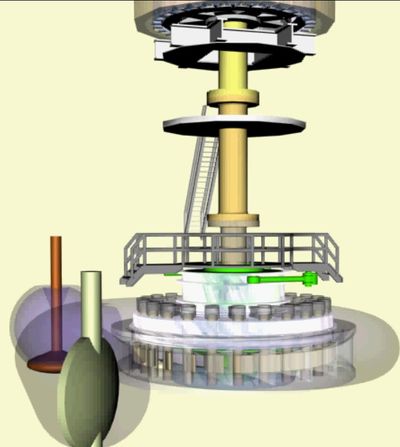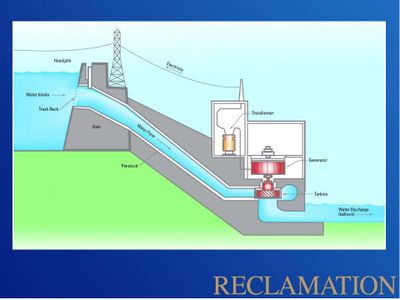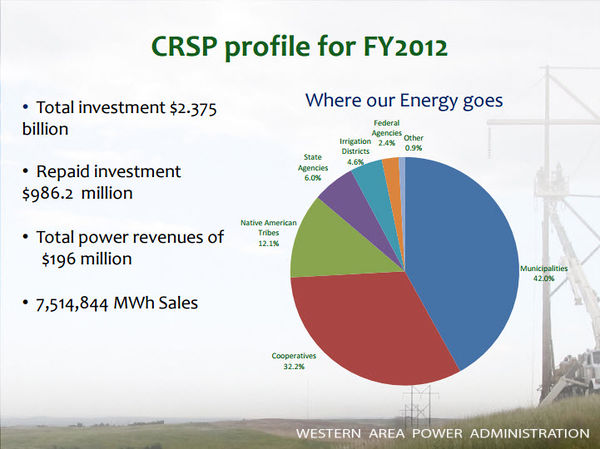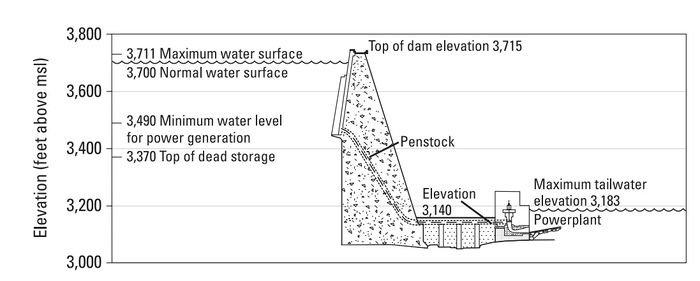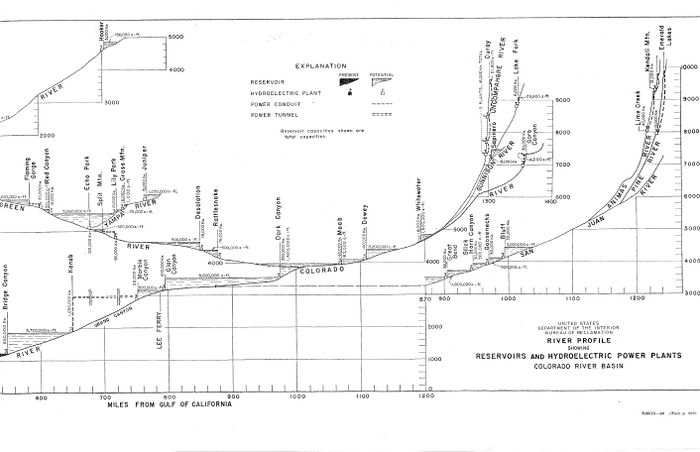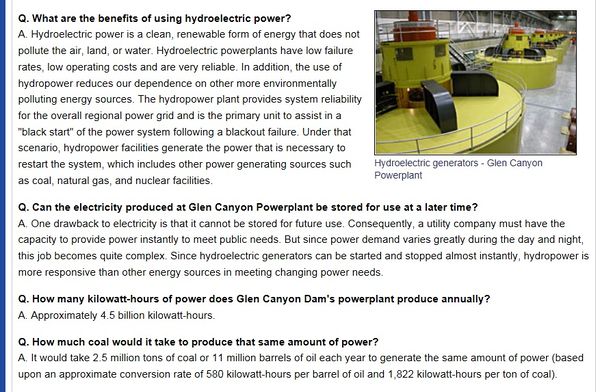Difference between revisions of "HYDROPOWER"
Cellsworth (Talk | contribs) |
Cellsworth (Talk | contribs) |
||
| (28 intermediate revisions by the same user not shown) | |||
| Line 21: | Line 21: | ||
[[Image:Generating Unit Flyaround- video clip USBR.jpg|center|400px]] <br> | [[Image:Generating Unit Flyaround- video clip USBR.jpg|center|400px]] <br> | ||
| − | [[Media:Flyaround.mp4|'''Fly Around Video Clip of Generating Unit''']] | + | [[Media:Flyaround.mp4 |'''Fly Around Video Clip of Generating Unit''']] |
| − | [[File:Water Intake Diagram.jpg|center| | + | [[File:Water Intake Diagram.jpg|center|400px]] |
<!-- | <!-- | ||
| Line 69: | Line 69: | ||
|style="color:#000;"| | |style="color:#000;"| | ||
| − | [[File: | + | [[File:BasinFund.PNG|center|thumb|600px|http://gcdamp.com/images_gcdamp_com/2/23/Jeka_PPT_Western_CRPS_Aug_2013_AMWG.pdf]] |
| − | [[File:CRSPprofile.jpg|center|600px]] | + | [[File:CRSPprofile.jpg|center|thumb|600px|http://gcdamp.com/images_gcdamp_com/2/23/Jeka_PPT_Western_CRPS_Aug_2013_AMWG.pdf]] |
| − | + | |- | |
| + | ! <h2 style="margin:0; background:#cedff2; font-size:120%; font-weight:bold; border:1px solid #a3b0bf; text-align:left; color:#000; padding:0.2em 0.4em;"> How does operations at Glen Canyon Dam fit into operations with other CRSP hydropower units? </h2> | ||
| + | |- | ||
| + | |style="color:#000;"| | ||
| − | [[File: | + | [[File:CRSP generation v demand.JPG|center|thumb|600px|https://www.usbr.gov/uc/progact/amp/twg/2018-01-25-twg-meeting/AR04.pdf]] |
| − | + | |- | |
| + | ! <h2 style="margin:0; background:#cedff2; font-size:120%; font-weight:bold; border:1px solid #a3b0bf; text-align:left; color:#000; padding:0.2em 0.4em;"> What is Regulation and how does Glen Canyon Dam provide it? </h2> | ||
| + | |- | ||
| + | |style="color:#000;"| | ||
| + | As a control area operator, Western “regulates” the transmission system within a prescribed geographic area. Western is required to react to moment-by-moment changes in electrical demand within this area. Regulation means that “automatic generation control” will be used to adjust the power output of electric generators within a prescribed area in response to changes in the system frequency, time error, and tie-line loading, to maintain the scheduled level of generation in accordance with prescribed NERC criteria. The “record” used to calculate the degree to which Western is responding to these change on the transmission system is called the “ACE” - Area Control Error. | ||
| − | + | Hydro facilities such as Glen Canyon have an inherent design that allows them to respond rapidly to changes in power system demands. Other control area operators, across the nation, that do not have hydropower plants must either build small units (natural gas or oil-fired being the most likely) or add this capability to the design of larger units. | |
| + | The transmission system that Western distributes power through is dynamic. Load requirements are constantly changing as a result of either the demands of the customers connected to it or changes that occur in other interconnected power systems. Western maintains the ACE signal to record its response to the fluctuations in system “loading”; (an effort to maintain a balance between power being consumed and power being generated - described above). If more demand is placed on the transmission system than is being generated, the resulting ACE is negative. Generators automatically respond to this condition by increasing generation. If demand is less than generation, ACE is positive. Generators automatically respond to this condition by reducing generation. The targeted ACE is zero. | ||
| + | |||
| + | The ACE signal that is sent to Glen Canyon where it is effectively added to, or subtracted from, the existing scheduled hourly generation base point. Therefore, at any moment during the day or night, Glen Canyon might be producing more or less power than the current hourly megawatt schedule. | ||
| + | |||
| + | The ACE signal is transmitted to Glen Canyon Dam every four seconds. The NERC requirement for regulation is that the ACE must “cross” the zero target every 10 minutes. The frequent “swings” in generation are described in the MOU signed by Reclamation and Western (4): | ||
| + | |||
| + | “These changes which occur many times during the hour are both positive and negative in relation to the schedule. The resulting output from Glen Canyon generators is an envelope of generation swings that are frequent, small in magnitude, the average of which approximates the original schedule.”[https://www.wapa.gov/regions/CRSP/PlanProject/Pages/glen-canyon-operations.aspx] | ||
| + | |||
| + | In addition to daily scheduled fluctuations for power generation, the instantaneous releases from Glen Canyon Dam may also fluctuate to provide 40 megawatts (mw) of system regulation. These instantaneous release adjustments stabilize the electrical generation and transmission system and translate to a range of about 1,200 cfs above or below the hourly scheduled release rate. Under system normal conditions, fluctuations for regulation are typically short lived and generally balance out over the hour with minimal or no noticeable impacts on downstream river flow conditions. | ||
| + | |||
| + | Releases from Glen Canyon Dam can also fluctuate beyond scheduled releases when called upon to respond to unscheduled power outages or power system emergencies. Depending on the severity of the system emergency, the response from Glen Canyon Dam can be significant, within the full range of the operating capacity of the power plant for as long as is necessary to maintain balance in the transmission system. Glen Canyon Dam typically maintains 30 mw (approximately 880 cfs) of generation capacity in reserve in order to respond to a system emergency even when generation rates are already high. System emergencies occur fairly infrequently and typically require small responses from Glen Canyon Dam. However, these responses can have a noticeable impact on the river downstream of Glen Canyon Dam. [https://www.usbr.gov/uc/water/crsp/cs/gcd.html] | ||
| + | |||
| + | |} | ||
| Line 92: | Line 112: | ||
|- | |- | ||
|style="color:#000;"| | |style="color:#000;"| | ||
| − | *[ | + | *[[The Basin Fund]] |
| − | + | ||
| − | + | ||
*[[GCDAMP- GTMAX| GTMax Page]] | *[[GCDAMP- GTMAX| GTMax Page]] | ||
| + | *[https://www.wapa.gov/Pages/western.aspx Western Area Power Administration (WAPA)] | ||
| + | *[https://www.credanet.org/#/ Colorado River Energy Distribution Association (CREDA)] | ||
| + | *[https://www.usbr.gov/power/index.html U.S. Bureau of Reclamation (USBR) Power Office] | ||
| + | *[https://gcdamp.com/index.php/GCDAMP_SEAHG_Page SocioEconomic Ad Hoc Group (SEAHG) page] | ||
|- | |- | ||
| Line 101: | Line 123: | ||
|- | |- | ||
|style="color:#000;"| | |style="color:#000;"| | ||
| + | |||
*[https://www.wapa.gov/newsroom/Publications/Documents/FY-2016-annual-report.pdf FY16 Annual Report] | *[https://www.wapa.gov/newsroom/Publications/Documents/FY-2016-annual-report.pdf FY16 Annual Report] | ||
*[https://www.wapa.gov/newsroom/Publications/Documents/FY-2016-statistical-appendix.pdf FY16 Statistical Appendix] | *[https://www.wapa.gov/newsroom/Publications/Documents/FY-2016-statistical-appendix.pdf FY16 Statistical Appendix] | ||
| Line 114: | Line 137: | ||
|- | |- | ||
|style="color:#000;"| | |style="color:#000;"| | ||
| + | |||
| + | '''2023''' | ||
| + | *[https://www.usbr.gov/uc/progact/amp/twg/2023-06-15-twg-meeting/20230615-ImpactsHydropowerCustomersBasinFundConductingExperiments-508-UCRO.pdf Impacts to Hydropower Customers and the Basin Fund from Conducting Experiments] | ||
| + | *[https://www.usbr.gov/uc/progact/amp/twg/2023-01-26-twg-meeting/20230126-AnnualReportingMeeting-GlenCanyonHydropowerProductionValue-508-UCRO.pdf Glen Canyon Hydropower Production and Value] | ||
| + | |||
| + | '''2022''' | ||
| + | *[https://www.usbr.gov/uc/progact/amp/twg/2022-10-13-twg-meeting/20221013-EffectsFrequentUseBypassGlenCanyonDamElectricalGenerationTransmission-508-UCRO.pdf Effects of Frequent Use of Bypass at Glen Canyon Dam on Electrical Generation and Transmission ] | ||
| + | *[https://www.usbr.gov/uc/progact/amp/twg/2022-10-13-twg-meeting/20221013-UpdateProjectNActivitiesIncludingDiscussionHydropowerImprovementFlows--508-UCRO.pdf Update on Project N Activities Including a Discussion of Hydropower Improvement Flows ] | ||
| + | |||
| + | '''2021''' | ||
| + | *[https://www.usbr.gov/uc/progact/amp/amwg/2021-02-11-amwg-meeting/20210211-ColoradoRiverStorageProjectMarketActivityUCBasinFundUpdates-508-UCRO.pdf Colorado River Storage Project Market Activity and UC Basin Fund Updates ] | ||
| + | *[[Media:AR_01-14-21.pdf| Glen Canyon Hydropower Production & Value: Status & Trends, 2020]] | ||
| + | |||
| + | '''2020''' | ||
| + | *[https://www.usbr.gov/uc/progact/amp/amwg/2020-02-12-amwg-meeting/20200212-GCMRCScienceUpdatesPart3-Presentation-508-UCRO.pdf GCMRC 2019 Annual Reporting Meeting Overview – Part 3 ] | ||
| + | *[https://www.usbr.gov/uc/progact/amp/amwg/2020-02-12-amwg-meeting/20200212-ColoradoRiverStorageProjectFundingUpdate-Presentation-508-UCRO.pdf Colorado River Storage Project Funding Update ] | ||
| + | *[https://www.usbr.gov/uc/progact/amp/amwg/2020-02-12-amwg-meeting/20200212-GlenCanyonOverview-Presentation-508-UCRO.pdf Glen Canyon Dam Overview ] | ||
| + | *[https://www.usbr.gov/uc/progact/amp/twg/2020-01-13-twg-meeting/20200113-AnnualReportingMeeting-IdentifyingTotalEconomicValueHydropowerGlenCanyonDam-Presentation-508-UCRO.pdf Identifying the total economic value of hydropower at Glen Canyon Dam and implications for adaptive management ] | ||
| + | |||
| + | '''2019''' | ||
| + | *[https://www.usbr.gov/uc/progact/amp/amwg/2019-03-06-amwg-meeting/20190306-ColoradoRiverEnergyDistributorsAssociation-Presentation-508-UCRO.pdf Colorado River Energy Distributors Association (CREDA)] | ||
| + | *[https://www.usbr.gov/uc/progact/amp/twg/2019-03-14-twg-meeting/20190314-GlenCanyonDamHydropowerProductionValueStatusTrends2019-Presentation-508-UCRO.pdf Glen Canyon Dam Hydropower Production and Value Status & Trends, 2019 ] | ||
'''2018''' | '''2018''' | ||
| − | *[https://www.usbr.gov/uc/ | + | *[https://qcnr.usu.edu/wats/colorado_river_studies/files/documents/Clayton.pdf The Future of the Colorado River] |
| + | *[https://www.usbr.gov/uc/progact/amp/amwg/2018-08-22-amwg-meeting/Attach_09.pdf Colorado River Storage Project (CRSP) PPT] | ||
| + | *[https://www.usbr.gov/uc/progact/amp/twg/2018-01-25-twg-meeting/AR04.pdf Glen Canyon Dam Hydropower Production and Value, Status and Trends 2018 PPT] | ||
'''2017''' | '''2017''' | ||
| − | *[https://www.usbr.gov/uc/ | + | *[https://www.usbr.gov/uc/progact/amp/twg/2017-01-26-twg-meeting/AR17_Ellsworth.pdf Status and Trends of Hydropower and Energy PPT] |
'''2016''' | '''2016''' | ||
| − | *[ | + | *[https://www.usbr.gov/uc/progact/amp/amwg/2016-08-24-amwg-meeting/Attach_08.pdf Basin Fund and Revenue Overview] |
'''2015''' | '''2015''' | ||
| − | *[https:// | + | *[https://www.usbr.gov/uc/progact/amp/amwg/2015-08-26-amwg-meeting/Attach_08.pdf CRSP Rates, Revenue, and Basin Fund Overview] |
'''2013''' | '''2013''' | ||
*[[Media:Jeka PPT Western CRPS Aug 2013 AMWG.pdf|Overview of the Colorado River Storage Project (CRSP) Management Center for Western Area Power Administration (WAPA)]] | *[[Media:Jeka PPT Western CRPS Aug 2013 AMWG.pdf|Overview of the Colorado River Storage Project (CRSP) Management Center for Western Area Power Administration (WAPA)]] | ||
| − | *[https://www.usbr.gov/uc/ | + | *[https://www.usbr.gov/uc/progact/amp/amwg/2013-08-08-amwg-meeting/Attach_13b.pdf Capacity and Energy Handout] |
| − | *[https://www.usbr.gov/uc/ | + | *[https://www.usbr.gov/uc/progact/amp/amwg/2013-08-08-amwg-meeting/Attach_13c.pdf Question & Answer Transcript] |
*[[Media:Wilhite HFEworkshop hydropower.pdf|High Flow Experiments: Financial and Operational Effects on CRSP and the Electric Power System]] | *[[Media:Wilhite HFEworkshop hydropower.pdf|High Flow Experiments: Financial and Operational Effects on CRSP and the Electric Power System]] | ||
| − | *[https://www.usbr.gov/uc/ | + | *[https://www.usbr.gov/uc/progact/amp/twg/2013-01-24-twg-meeting/Attach_12.pdf Final Products of the 2011 Hydropower Knowledge Assessment and GTMax Model Review Workshop Dated January 4, 2012] |
'''2010''' | '''2010''' | ||
| − | *[https://www.usbr.gov/uc/ | + | *[https://www.usbr.gov/uc/progact/amp/twg/2010-03-15-twg-meeting/Attach_06.pdf Electrical Power System Economics] |
'''2009''' | '''2009''' | ||
*[[Media:CREDA Brief 2-20-09 FINAL 737pm.pdf| CREDA brief on “the generation of hydroelectric power, as an incident of the foregoing purposes.”]] | *[[Media:CREDA Brief 2-20-09 FINAL 737pm.pdf| CREDA brief on “the generation of hydroelectric power, as an incident of the foregoing purposes.”]] | ||
| − | *[https://www.usbr.gov/uc/ | + | *[https://www.usbr.gov/uc/progact/amp/twg/2009-09-29-twg-meeting/Attach_16.pdf Life Cycle Impact Assessment of Renewable Electrical Generation Technologies Compared to the WECC Baseline] |
| − | *[https://www.usbr.gov/uc/ | + | *[https://www.usbr.gov/uc/progact/amp/amwg/2009-08-12-amwg-meeting/Attach_04a.pdf Energy and Water Development Appropriations bill, 2010 language (note last paragraph on GCD Adaptive Management Program)] |
| − | *[https://www.usbr.gov/uc/ | + | *[https://www.usbr.gov/uc/progact/amp/amwg/2009-08-12-amwg-meeting/Attach_04b.pdf Letter from various U.S. senators, to Daniel Inouye, Byron Dorgan, etc., Subj: Concerns on Energy and Water Development Appropriations Bill, H.R. 3183] |
|- | |- | ||
| Line 151: | Line 198: | ||
*[[Media:Generation at Outlet Glen Canyon Dam Plan of Study CRSP Power Peaking Capacity (March 1981).pdf|Generation at Outlet Glen Canyon Dam Plan of Study CRSP Power Peaking Capacity (March 1981)]] | *[[Media:Generation at Outlet Glen Canyon Dam Plan of Study CRSP Power Peaking Capacity (March 1981).pdf|Generation at Outlet Glen Canyon Dam Plan of Study CRSP Power Peaking Capacity (March 1981)]] | ||
| + | |||
| + | |- | ||
| + | ! <h2 style="margin:0; background:#cedff2; font-size:120%; font-weight:bold; border:1px solid #a3b0bf; text-align:left; color:#000; padding:0.2em 0.4em;"> What does it mean that "generation of hydroelectric power is an incident of the foregoing purposes" in [https://www.usbr.gov/uc/rm/crsp/index.html the 1956 CRSP Act (43 U.S.C. § 620)]? </h2> | ||
| + | |- | ||
| + | |style="color:#000;"| | ||
| + | |||
| + | In GRAND CANYON TRUST vs U.S. BUREAU OF RECLAMATION, Grand Canyon Trust asserted that “[h]ydropower is an incidental benefit of every other stated purpose of the dam,” citing 43 U.S.C. § 620. Pl. Reply at p. 39. This is not a | ||
| + | correct statement of the law. The relevant portion of 43 U.S.C. § 620 provides “for the generation of hydroelectric power, as an incident of the foregoing purposes.” Congress did not provide that hydropower is “incidental to” or “an incidental benefit of” the Colorado River Storage Project. Hydropower is an “incident of” the other Congressionally defined purposes. Used in this manner and in this context, the word “incident” means “related to,” or “resulting from,” and does not mean that hydropower resources are an “incidental” or minor authorized purpose of the Colorado River Storage Project. [[Media:CREDA Brief 2-20-09 FINAL 737pm (1).pdf|[1]]] | ||
| + | |||
| + | |- | ||
| + | ! <h2 style="margin:0; background:#cedff2; font-size:120%; font-weight:bold; border:1px solid #a3b0bf; text-align:left; color:#000; padding:0.2em 0.4em;"> Ramp rates and beach stability </h2> | ||
| + | |- | ||
| + | |style="color:#000;"| | ||
| + | |||
| + | [https://asu.pure.elsevier.com/en/publications/erosion-of-river-sandbars-by-diurnal-stage-fluctuations-in-the-co Alvarez and Schmeeckle (2013)] that found that the erosion of sandbars (the primary reason we have ramp rate restrictions at Glen) are not affected by ramp rates themselves. They found that erosion of sandbars is primarily caused by the higher velocity flows that washes the toe of the sandbar away which then causes the rest of the sandbar to slough off and fall into the river (i.e. mass failure). Having flows come up or go down more quickly than they do now will not increase this rate of erosion aside from the fact that the faster you can come up and go down allows you more time on peak at those higher velocity flows, which was identified as the causal factor of sandbar erosion. | ||
|- | |- | ||
| Line 169: | Line 231: | ||
[[File:Reservoirs Hydro ColoradoRiver.jpg|center|700px]] | [[File:Reservoirs Hydro ColoradoRiver.jpg|center|700px]] | ||
| + | |||
| + | [[File:USBR- Q& A on GCD Hydropower.jpg|center|600px|lect|USBR- Q& A on GCD Hydropower]] | ||
| + | |||
<br> | <br> | ||
|} | |} | ||
Latest revision as of 11:32, 11 April 2024
|
|
The Hydropower ResourceGlen Canyon Dam is the second highest (710 feet) concrete-arch dam in the United States, second only to Hoover Dam which stands at 726 feet. The 26.2 million acre-feet of water storage capacity in Lake Powell, created by Glen Canyon Dam, serves as a ‘bank account’ of water that is drawn on in times of drought. This stored water has made it possible to successfully weather extended dry periods by sustaining the needs of cities, industries, and agriculture throughout the West. Hydroelectric power produced by the dam’s eight generators helps meet the electrical needs of the West’s rapidly growing population. With a total capacity of 1,320 megawatts, Glen Canyon Powerplant produces around five billion kilowatt-hours of hydroelectric power annually which is distributed by the Western Area Power Administration to Wyoming, Utah, Colorado, New Mexico, Arizona, Nevada, and Nebraska. In addition, revenues from production of hydropower help fund many important environmental programs associated with Glen and Grand canyons. The designation of Glen Canyon National Recreation Area in 1972, underscores the value and importance of the recreation benefits associated with Lake Powell and the Colorado River downstream of the dam. The GCNRA is managed by the National Park Service. Glen Canyon Dam is the key water storage unit of the Colorado River Storage Project, one of the most complex and extensive river resource developments in the world. Without it, development of the Upper Colorado River Basin states’ portion of the Colorado River would not have been possible. [1] LTEMP Resource Goal for the Hydropower ResourceMaintain or increase Glen Canyon Dam electric energy generation, load following capability, and ramp rate capability, and minimize emissions and costs to the greatest extent practicable, consistent with improvement and long-term sustainability of downstream resources. Desired Future Condition for the Hydropower Resource• Glen Canyon Dam capacity and energy generation is maintained and increased, so as to produce the greatest practicable amount of power and energy, consistent with the other DFCs. |
| --- |
Hydropower - Online Training |
--- |
|---|
|
